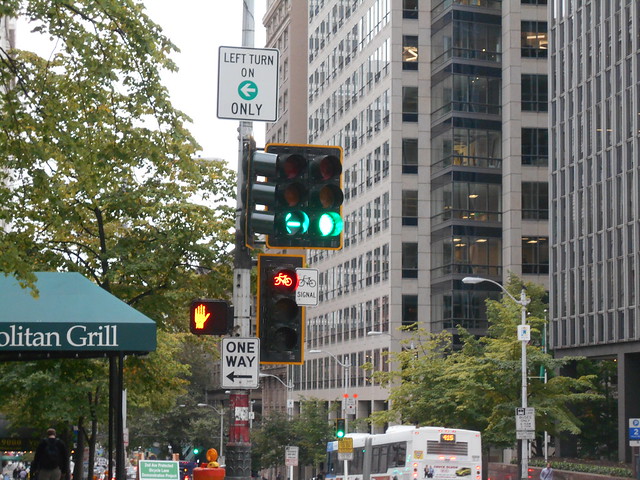
In yesterday’s morning article, Guy gave us his initial impressions of the new Second Avenue Protected Bike Lanes, and a few suggestions about how they could be improved. One thing that he had suggested was traffic light changes for left-turning and straight-through traffic at intersections along Second Avenue.
During the first few days, there was a significant amount of confusion amongst drivers about what they could and couldn’t do when lights changed on Second Avenue. The initial set up was three distinct lights: one for bikes, one for left-turning drivers, and one for straight-through southbound drivers. Left turning lights were indicated by arrows while straight-through soundbound traffic lights were indicated by the normal solid circles. Many drivers became confused with this set up. Assuming a green circle permitted all traffic movements, they ignored the red left turn arrow and would proceed to cross the bike lanes. This presented a dangerous situation because cyclists were given a green when left turning car traffic was given a red.
As Guy noted, the Seattle Department of Transportation (SDOT) had been very responsive to the comments of drivers and cyclists alike. Many of those comments were in support of the simple up arrow light solution for straight-through traffic. By the time Guy’s article had gone live, SDOT had rolled out that exact solution, in addition to posting large “no turn on left” signs at intersections. As you can see below, it’s much clearer about how drivers should proceed while turning left or going southbound along Second Avenue. SDOT has been super proactive with this project, which probably shouldn’t come as a surprise, but it’s deeply appreciated.
New up arrows installed. pic.twitter.com/XTZnp2IvwX
— Dongho Chang (@dongho_chang) September 11, 2014
A near-side bike signal would definitely be helpful. Saw several people slam on brakes b/c they saw the red bike late pic.twitter.com/mauD1m4bQv
— Seattle Bike Blog (@seabikeblog) September 11, 2014
Crews installing signs this morning pic.twitter.com/ycp3BZvKmo
— Dongho Chang (@dongho_chang) September 11, 2014
I've been at 2nd & University for a half hour now. Almost everyone now following the turn arrow & bike signal. Good job, @seattledot!
— Seattle Bike Blog (@seabikeblog) September 11, 2014
Stephen is a professional urban planner in Puget Sound with a passion for sustainable, livable, and diverse cities. He is especially interested in how policies, regulations, and programs can promote positive outcomes for communities. With stints in great cities like Bellingham and Cork, Stephen currently lives in Seattle. He primarily covers land use and transportation issues and has been with The Urbanist since 2014.



